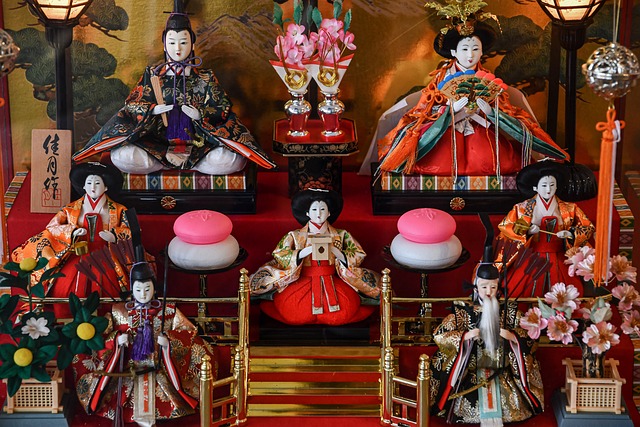
Steeped in centuries of rich cultural heritage, the Ome City Hina Doll Festival stands as a time-honored celebration deserving of admiration and fascination. Nestled amidst the captivating landscapes of the Tama region in Tokyo, this vibrant festival sheds light on the cherished Japanese tradition of displaying intricately crafted Hina dolls—symbols of prosperity and protection.
With a history reaching back to the Heian period (794-1185), the Hina Doll Festival remains an integral part of Japanese society and one of its most famous festivals, fostering a deep connection to the past while enchanting observers with its exquisitely detailed artistry. Held annually during the month of March, the festival serves as a testament to the reverence the Japanese hold towards their cultural roots and the customs passed down through generations.
Historical Background:
The Hina Doll Festival, also known as Hinamatsuri, has its roots in the Heian period (794-1185) of Japanese history. During this time, the festival was primarily celebrated within the imperial court, where it served as a display of wealth and power. The Hina dolls, meticulously crafted and adorned with elaborate traditional attire, represented various members of the emperor’s court, ranging from the emperor and empress to attendants and musicians.
Over time, the Hina Doll Festival gradually spread beyond the imperial court and became a cherished tradition among the general populace. As the festival gained popularity, it also evolved to include elements of prayers for health, happiness, and success for young girls. Families began displaying Hina dolls in their homes, with the belief that they would bring protection and good fortune to their daughters.
Symbolism and Superstitions
Each doll holds a symbolic meaning within the festival. The emperor and empress dolls represent the ultimate power and authority, while the attendants and musicians symbolize a harmonious court. These dolls are typically displayed on multiple tiers covered with a red cloth, displaying the hierarchical structure of the imperial court.
Superstitions have also surrounded the Hina dolls throughout history. It was believed that the dolls possessed the ability to absorb evil spirits, which led to the custom of removing them from the homes swiftly once the festival concludes. It was thought that leaving the dolls displayed for too long could result in delayed marriage or difficulties in finding a suitable partner for young girls.

Significance of the Festival
Beyond its decorative and symbolic aspects, the Hina Doll Festival holds deep cultural significance in Japan. The festival serves as a reminder of the country’s historical ties and traditions, fostering a sense of pride and connection to the past. It reinforces the values of family, respect for elders, and the importance of passing down customs and heritage from generation to generation.
The Hina Doll Festival is not merely a celebration of artistry and craftsmanship; it embodies the essence of Japanese tradition and cultural identity. Through the medium of beautifully crafted dolls, the festival captures the imagination and transports participants into a bygone era of elegance and grace. As Ome City proudly embraces this centuries-old tradition, visitors from near and far are invited to witness the captivating beauty and importance of the Hina Doll Festival, a true testament to Japan’s rich cultural heritage.
Doll Displays and Exhibitions
The heart of the Ome City Hina Doll Festival lies in its mesmerizing doll displays and exhibitions. Each year, the city transforms into a living gallery, showcasing the meticulous craftsmanship and artistic mastery in the creation of these exquisite Hina dolls. Visitors are treated to a visual feast as they explore the various displays scattered throughout the city, each one offering a unique perspective on Japanese culture and tradition.
The Imperial Court
In this section, visitors can marvel at the grandeur and opulence of the emperor and empress dolls, representing the highest authority within the imperial court. Posed on the top tier of the display, these dolls are adorned in elaborate traditional dress and adorned with ornate accessories, reflecting the power and prestige they symbolize. Surrounding them are figures representing their attendants and court musicians, showcasing a microcosm of court life.

Everyday Scenes
Moving down from the imperial court, visitors can step into the vibrant world of ordinary townspeople depicted by the Hina dolls. These dolls portray scenes of everyday life, from a mother soothing her baby to artisans honing their craft. Each doll captures a glimpse into the joys, struggles, and dynamics of Japanese society during the Heian period, providing a window into the past.
Regional Representation
One of the most intriguing aspects of the Ome City Hina Doll Festival is the inclusion of dolls representing different regions of Japan. These dolls incorporate regional design elements, costumes, and customs, exemplifying the diversity and richness of Japanese culture. Visitors can experience a miniaturized journey through various regions, appreciating the distinctiveness of each area as depicted by the intricately crafted dolls.

Artistry Unveiled
Within select exhibitions, visitors have the rare opportunity to witness live demonstrations by master doll makers. These artisans showcase their skills, demonstrating the meticulous attention to detail and precision required to create these miniature works of art. Visitors can observe the delicate brush strokes, the intricacies of the doll’s clothing, and the painstaking process of bringing life to each doll.
As part of the festival, Ome City offers interactive workshops where visitors can engage in the art of doll-making. Participants can learn the techniques behind creating Hina dolls, from painting delicate facial features to hand-sewing intricate garments. These workshops provide a unique opportunity to connect with Japan’s rich craft traditions and gain a deeper appreciation for the artistry involved in the creation of Hina dolls.
More about Ome City
Ome City is nestled in the western part of Tokyo, Japan, and is known for its natural beauty and rich culture. The city is surrounded by mountains and is home to numerous hot springs, making it a popular retreat for travelers seeking relaxation and rejuvenation. The city is also known for its traditional Japanese crafts, such as pottery and calligraphy, which are passed down from generation to generation.
Ome City is rich in history, and visitors can explore ancient temples and shrines, such as the Ome Kannon Temple and the Kushi-Kimizuka Burial Mound. The city is also famous for its scenic hiking trails, including the Mitake Gorge and the Ome Hino Hills, which offer breathtaking views of the surrounding landscape. In addition to the Hina Doll Festival, Ome City hosts numerous other cultural events throughout the year, such as the Ome Sakura Festival, where visitors can admire the beauty of cherry blossoms in full bloom. With its combination of natural beauty and cultural heritage, Ome City truly offers something for everyone.

